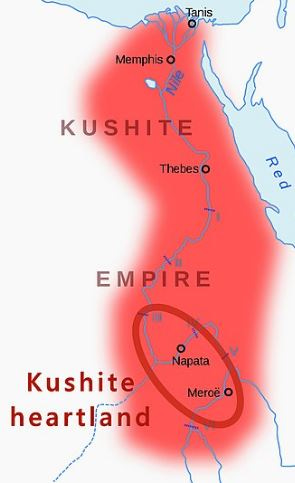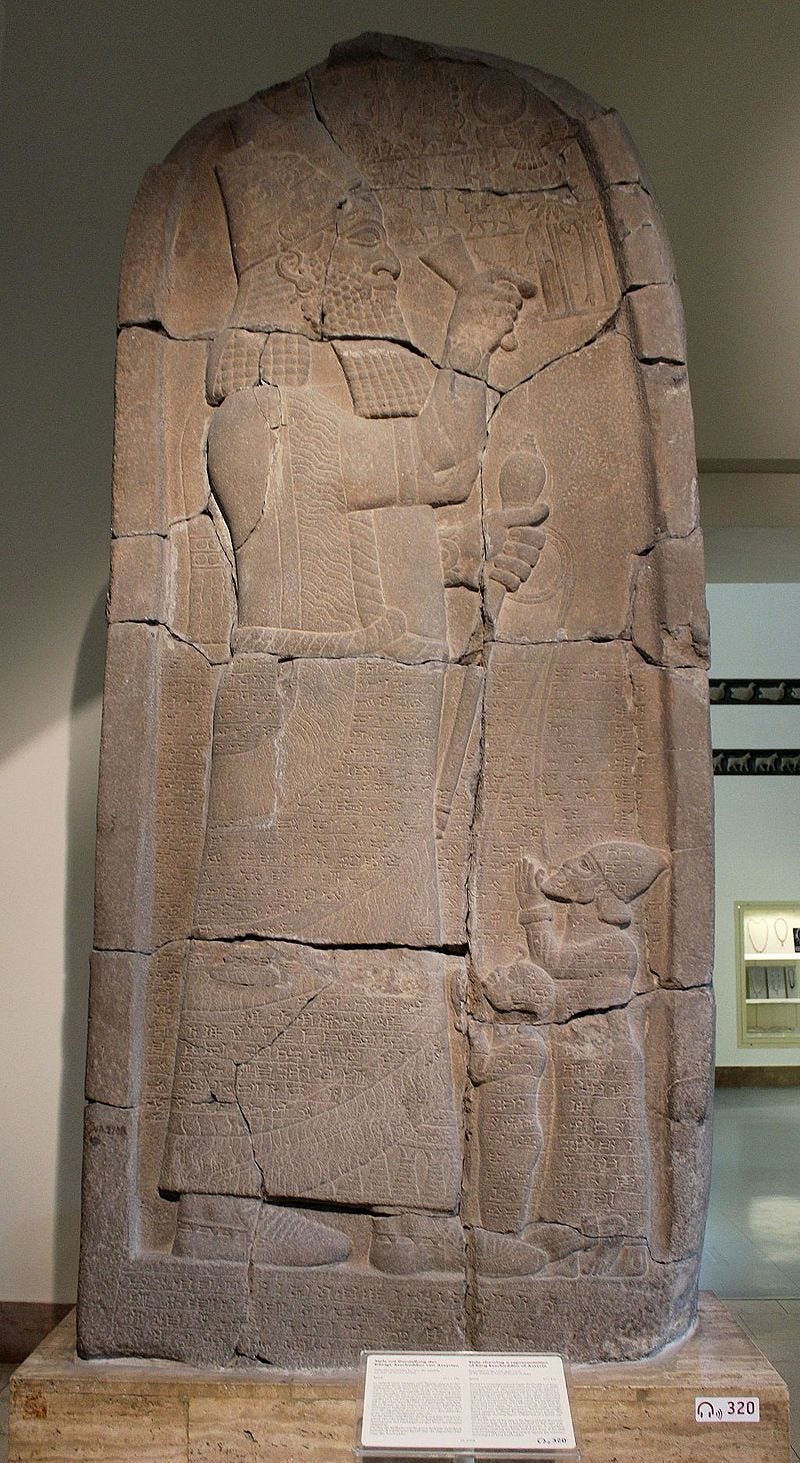First up of Ham’s children is Cush. The term “Cush” is widely used in Rabbinic literature as the word for “Black” Africans specifically, this heavily implies Cush’s origin is located in Africa, and we will see that the majority of Ham’s descendants also come from Africa, even if they migrate elsewhere. However, unlike the other children, Cush is the only one specifically used to refer to those of darker skin tones, similar to the way Greeks would use the term Pelasgoi to mean anyone of a darker shade. However, it is unclear if Cushite always meant “black” specifically, since we will see some of the descendants of Cush are anything but proto-typically “black.”
Surprisingly we actually have a record of a form of this name from Mesopotamia during the Uruk period dated between 3400-3000 BCE during the earliest periods of political complexity and unification of complex human civilizations. Appearing on a tablet related to some sort of barley transaction accounting we get the name “Ku-shim” which is essentially identical to the name Cush. It is unclear if this is a person's name, or a group's name, but for our purposes this is some very hard evidence that “Cush” was a name from a much older memory than any of the other names, even if the name in this Mesopotamian context is wholly unrelated to the Hamite Cush. This possibility should not be ruled out since ultimately there is no geographic limitation to Africa for the extent of Ham’s children, or their associated empires.
Not only do we have a record for this name, unlike a majority of Noah’s generations, this is actually the oldest recorded human name (that we have found currently). It is not merely “a name”, but coming earlier than any other name, and first on the list of Noah’s son Ham would help explain why Cush was seen as coming before Mizraim. This helps verify Cush’s temporal location as the “first son of Ham”, but also why the only other son to potentially date as far back as Cush would be Elam son of Shem. Of course Japheth, or Iapetos, likely dates back as well to an earlier time, we only have later Bronze Age records for the form of this name, and the Indo-Europeans were still fairly connected up until 3000 BCE and had yet to begin their rapid expansion out of the steppe.
Considering the fact writing was quite an expensive task in this period and only the most wealthy or educated would have the skills necessary to write means Cush was not just some random person, but a fairly notable, and highly revered name. The transplanting of this name from Mesopotamia to Egypt especially makes sense if this Kushim was a barley trader, or worked inside that industry given the prominent role of barley trading in this period. If there were a group of Kushim, or sons of Cush who were heavily involved in trading, that does give us some methodology for how the name, or a section of their family, migrated to, or from, Egypt. It also may help explain Nimrod, reportedly a “son of Kush”, who is a founder of Mesopotamian cities rather than African. If this theory holds true, then we can see Ham “coming from Mesopotamia”, with his sons Cush and Nimrod. It may also explain why so many locations in Arabia have names mirroring those of Cush’s children, due to them originally founding these cities and possibly having the Shemites only later settle these territories.
Mizraim, otherwise known as Egypt, clearly was influenced by Cush in some form, but it’s unclear how, or when this name shifted to referring to Africa rather than Mesopotamia. There were major trade contacts between the two nations, and the Pharaoh just prior to the unification of Upper and Lower Egypt was named “Scorpion II” who continually uses clear Mesopotamian motifs and imagery in his reliefs and art hinting at an interconnected political culture. Importantly Scorpion was the last of the ununified Pharaohs before this influence wanes and Egyptian culture takes a more indigenous African form signifying a potential origin for Pharaonic culture ultimately being foreign in origin.
One place to start our search in Africa for a ‘Cush’ would be the obvious “Kingdom of Kush” located in modern Sudan, south of Egypt. These Kushites actually conquered and dominated the entirety of Egypt circa 700 BCE after establishing their dynasty as far back as 1000 BCE. However their empire may have been based around the earlier Kerma Kingdom, a City State that exerted influence over much of the Kushite heartland. This Kerma Culture began to flourish in the year 3000 BCE, becoming a large city by 2500 BCE, and by 1700 hosting quite a massive population, by ancient standards, of 10,000 inhabitants.
Typically both the Kerma and Kushite’s formed their power base in the cataract region of the Nile, where the changing flow heights would enable a clear separation between the North and South Nile regions. This boundary marks the traditional cultural dissociation point between “Egypt” and “Kush” and made it difficult for the Egyptian kingdoms to project their power into Kush, making Kush a consistent threat for Egypt. It is evident from Egyptian colonies and fortifications from around the year 2100 BCE between the 2nd and 3rd cataracts that military threats from this region were becoming quite a problem. These cataracts often served as major defense barriers for Egypt due to the way in which the river narrows, often around rocky waters, forcing the flow to become more rapid, creating waterfall-like conditions that prevent navigation by ship. Just beyond this 3rd cataract is the location of Kerma, being difficult for either side to originally exert power beyond.
This was not the only regional difference, however, as both Egypt and Kush were divided into Lower, and Upper halves. Lower Egypt being the delta region around Memphis, and Upper Egypt centered around the city of Thebes in the ‘south’. In this context “upper” meant physically higher, as the Nile flows downwards from progressively lower plateaus.
In Kush the region was again divided into Lower and Upper halves, with the lower half being the earliest kingdom centered around Kerma. The later Kingdom of Kush was centered on the city of Napata and Meroe in Upper Nubia, which to this day contain magnificent pyramids and ancient structures mirror dynastic Egyptian pharaohs. We will dig into the differences between these states, regions, and peoples over the coming chapters to uncover the sons of Cush.
There are few records detailing the lives of Kerma Kings, but records from the later Upper Kushite period are diverse. The most notable leader of ‘upper’ Kush was King Taharqa, mentioned in Assyrian chronicles as the frequent ally of the Israelites and major chief rival to ascendant Assyrian power. We find in Assyrian records that Esarhaddon even took the son of Taharqa, Ushankhuru, captive, depicted in his victory stele, indicating Kush was well integrated into the ancient geopolitical structure. In Hebrew he is known as “Tirhakah” (תִּרְהָקָה) Who waged war against king Sennacherib during the reign of Hezekiah.1
In the Book of Nahum, in reference to the renowned Sack of Thebes by the Assyrians and collapse of Taharqa’s kingdom, we find lines referencing many of the brothers, and children of Ham.
“Art thou better than populous No, that was situated among the rivers, that had the waters round about it, whose rampart was the sea, and her wall was from the sea? Ethiopia and Egypt were her strength, and it was infinite; Put and Lubim were thy helpers. Yet was she carried away, she went into captivity: her young children also were dashed in pieces at the top of all the streets: and they cast lots for her honorable men, and all her great men were bound in chains”2
Notably we can find Egypt and Put, and well as Lubim, even Ethiopia, all nations we will uncover geographic locals for in the coming pages. Mentioned among these allies of Taharqa are Phoenicia, and Canaanite cities whom Taharqa often attempts to cultivate a shared relationship with, possibly owing to an appeal to a related ethnic background. Taharqa himself is not the identification of Cush, but rather a much later 7th century figure, as clearly indicated in the prophecies of the prophets. This makes sense conceptually due to Taharqa’s power base being centered around Napata, located in Upper Nubia, rather than Lower Nubia where the first Kingdom would have started. By the time of the dissolution of the Kingdom of Nubia, the region splintered into essentially three distinct political entities. While many of these polities are from later eras, the ethnic substructure that underlined their power base was already well in place, and likely a holdover from earlier eras. If America were to break into multiple entities, no one would be shocked if a distinct western, eastern, and southern American nation were to form as their culture was developed inside a unified whole. This is similar to Kush and his children.
This is part one of what will be a two part series on Cush. Next time we will dive further into Cush and the regions of Nile to start carving out spots for his sons on the Table of Nations.
Don’t forget to like, subscribe, and comment since all of these help me immensely. Feel free to contact me for any comments as usual, and I sincerely appreciate your support and readership. Thank you.
2 Kings 19:9 and Isaiah 37:9
Nahum 3:8-10






